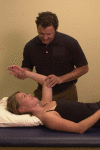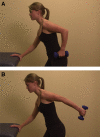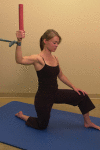Rehabilitation after arthroscopic rotator cuff repair: current concepts review and evidence-based guidelines
- PMID: 22530194
- PMCID: PMC3325631
Rehabilitation after arthroscopic rotator cuff repair: current concepts review and evidence-based guidelines
Abstract
Purpose: To provide an overview of the characteristics and timing of rotator cuff healing and provide an update on treatments used in rehabilitation of rotator cuff repairs. The authors' protocol of choice, used within a large sports medicine rehabilitation center, is presented and the rationale behind its implementation is discussed.
Background: If initial nonsurgical treatment of a rotator cuff tear fails, surgical repair is often the next line of treatment. It is evident that a successful outcome after surgical rotator cuff repair is as much dependent on surgical technique as it is on rehabilitation. To this end, rehabilitation protocols have proven challenging to both the orthopaedic surgeon and the involved physical therapist. Instead of being based on scientific rationale, traditionally most rehabilitation protocols are solely based on clinical experience and expert opinion.
Methods: A review of currently available literature on rehabilitation after arthroscopic rotator cuff tear repair on PUBMED / MEDLINE and EMBASE databases was performed to illustrate the available evidence behind various postoperative treatment modalities.
Results: There is little high-level scientific evidence available to support or contest current postoperative rotator cuff rehabilitation protocols. Most existing protocols are based on clinical experience with modest incorporation of scientific data.
Conclusion: Little scientific evidence is available to guide the timing of postsurgical rotator cuff rehabilitation. To this end, expert opinion and clinical experience remains a large facet of rehabilitation protocols. This review describes a rotator cuff rehabilitation protocol that incorporates currently available scientific literature guiding rehabilitation.
Keywords: Arthroscopic rotator cuff repair; rehabilitation; scientific rationale.
Figures















References
-
- Lin J.C.Weintraub N., Aragaki D.R. Nonsurgical treatment for rotator cuff injury in the elderly. J Am Med Dir Assoc. 2008. 9(9): p. 626–32 10.1016/j.jamda.2008.05.003. - PubMed
-
- Boykin R.E.Heuer H.J.Vaishnav S.Millett P.J. Rotator Cuff Disease: Basics of diagnosis and treatment. Rheumatology Reports. 2010(2:e1): p. 1–12
-
- Bennett W.F. Arthroscopic repair of massive rotator cuff tears: a prospective cohort with 2- to 4-year follow-up. Arthroscopy. 2003. 19(4): p. 380–90 10.1053/jars.2003.50131 - PubMed
-
- Brox J.I.Gjengedal E.Uppheim G.et al. Arthroscopic surgery versus supervised exercises in patients with rotator cuff disease (stage II impingement syndrome): a prospective, randomized, controlled study in 125 patients with a 2 1/2-year follow-up. J Shoulder Elbow Surg. 1999. 8(2): p. 102–11 - PubMed
-
- Budoff J.E.Nirschl R.P., Guidi E.J. Debridement of partial-thickness tears of the rotator cuff without acromioplasty. Long-term follow-up and review of the literature. J Bone Joint Surg Am. 1998. 80(5): p. 733–48 - PubMed
LinkOut - more resources
Full Text Sources
Other Literature Sources
